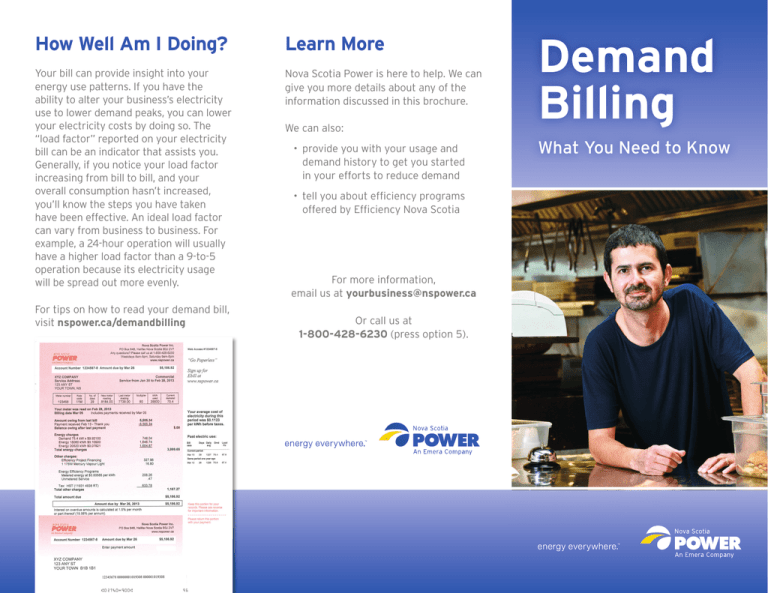Demand Meter Brochure 13th Try 4_13.indd
advertisement

How Well Am I Doing? Learn More Your bill can provide insight into your energy use patterns. If you have the ability to alter your business’s electricity use to lower demand peaks, you can lower your electricity costs by doing so. The “load factor” reported on your electricity bill can be an indicator that assists you. Generally, if you notice your load factor increasing from bill to bill, and your overall consumption hasn’t increased, you’ll know the steps you have taken have been effective. An ideal load factor can vary from business to business. For example, a 24-hour operation will usually have a higher load factor than a 9-to-5 operation because its electricity usage will be spread out more evenly. Nova Scotia Power is here to help. We can give you more details about any of the information discussed in this brochure. For tips on how to read your demand bill, visit nspower.ca/demandbilling We can also: • provide you with your usage and demand history to get you started in your efforts to reduce demand • tell you about efficiency programs offered by Efficiency Nova Scotia For more information, email us at yourbusiness@nspower.ca Or call us at 1-800-428-6230 (press option 5). Demand Billing What You Need to Know What Is Demand Billing? Demand billing is a standard practice used throughout North America to fairly recover costs from some business customers who use more than a specified amount of electricity during peak periods. Demand bills have two components: the total amount of electricity used (the energy charge), and the highest amount used within a 15-minute interval at any time during the customer’s billing period (the demand charge). How Is My Bill Amount Determined? There are three components to the calculation of a General Rate 11 bill: • Demand charge (demand x demand charge) • + First energy block charge (first 200 kWh x demand x energy charge) • + Second energy block charge (all remaining kWh x energy charge) How Can My Business Use Electricity Effectively? Understanding when and how your business consumes electricity can help you better manage your demand and spend less. If you reduce energy consumption, you could reduce your overall demand. Note, though, it is important to be consistent with your demand management. One lapse could spike your demand to its previous level, which will undo your demand reduction efforts for that month. Here are some more tips for reducing your demand: Furnaces and Water Heaters A properly sized heating system will also reduce demand and provide greater comfort for your staff and customers. Improve efficiency and reduce demand by installing a heat pump water heater. Appliances Install appliances with energy star ratings. If you use equipment controlled by thermostats such as grills, fryers, and coffee makers, try staggering startup times in 15-minute intervals. These appliances often require more electricity when heating up. If you start them so the warm-up periods do not overlap, you can reduce your demand. Lighting To find out more on how your bill is calculated visit: www.nspower.ca/demandbilling sodium lights are also more efficient than incandescent lights. They use fewer watts, while producing the same amount of light. Consider fluorescent lighting. It uses less electricity to produce the same amount of light as incandescent bulbs. High-pressure Flexible Scheduling Look for ways to schedule work and business tasks with electricity demand in mind. Each appliance you use adds to your demand. If you can avoid using several large appliances at the same time, you can reduce spikes in demand.
